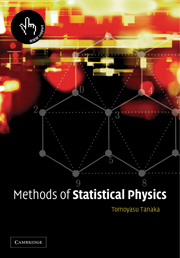Book contents
- Frontmatter
- Contents
- Preface
- Acknowledgements
- 1 The laws of thermodynamics
- 2 Thermodynamic relations
- 3 The ensemble theory
- 4 System Hamiltonians
- 5 The density matrix
- 6 The cluster variation method
- 7 Infinite-series representations of correlation functions
- 8 The extended mean-field approximation
- 9 The exact Ising lattice identities
- 10 Propagation of short range order
- 11 Phase transition of the two-dimensional Ising model
- Appendix 1 The gamma function
- Appendix 2 The critical exponent in the tetrahedron approximation
- Appendix 3 Programming organization of the cluster variation method
- Appendix 4 A unitary transformation applied to the Hubbard Hamiltonian
- Appendix 5 Exact Ising identities on the diamond lattice
- References
- Bibliography
- Index
1 - The laws of thermodynamics
Published online by Cambridge University Press: 06 July 2010
- Frontmatter
- Contents
- Preface
- Acknowledgements
- 1 The laws of thermodynamics
- 2 Thermodynamic relations
- 3 The ensemble theory
- 4 System Hamiltonians
- 5 The density matrix
- 6 The cluster variation method
- 7 Infinite-series representations of correlation functions
- 8 The extended mean-field approximation
- 9 The exact Ising lattice identities
- 10 Propagation of short range order
- 11 Phase transition of the two-dimensional Ising model
- Appendix 1 The gamma function
- Appendix 2 The critical exponent in the tetrahedron approximation
- Appendix 3 Programming organization of the cluster variation method
- Appendix 4 A unitary transformation applied to the Hubbard Hamiltonian
- Appendix 5 Exact Ising identities on the diamond lattice
- References
- Bibliography
- Index
Summary
The thermodynamic system and processes
A physical system containing a large number of atoms or molecules is called the thermodynamic system if macroscopic properties, such as the temperature, pressure, mass density, heat capacity, etc., are the properties of main interest. The number of atoms or molecules contained, and hence the volume of the system, must be sufficiently large so that the conditions on the surfaces of the system do not affect the macroscopic properties significantly. From the theoretical point of view, the size of the system must be infinitely large, and the mathematical limit in which the volume, and proportionately the number of atoms or molecules, of the system are taken to infinity is often called the thermodynamic limit.
The thermodynamic process is a process in which some of the macroscopic properties of the system change in the course of time, such as the flow of matter or heat and/or the change in the volume of the system. It is stated that the system is in thermal equilibrium if there is no thermodynamic process going on in the system, even though there would always be microscopic molecular motions taking place. The system in thermal equilibrium must be uniform in density, temperature, and other macroscopic properties.
The zeroth law of thermodynamics
If two thermodynamic systems, A and B, each of which is in thermal equilibrium independently, are brought into thermal contact, one of two things will take place: either (1) a flow of heat from one system to the other or (2) no thermodynamic process will result.
- Type
- Chapter
- Information
- Methods of Statistical Physics , pp. 1 - 37Publisher: Cambridge University PressPrint publication year: 2002



